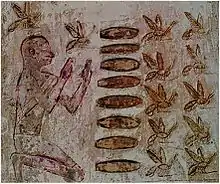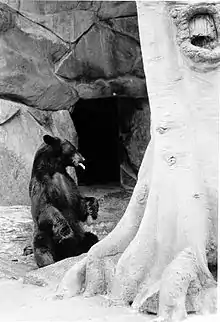
Mellivory is a term for the eating of honey. Honey is a sweet and viscous substance created by some eusocial insects, notably bees, for consumption by members of their hives, especially their young. Honey is also consumed by many other animals including human beings, who have developed beekeeping to make supplies of honey both reliable and plentiful. Despite honey's limited antimicrobial properties (caused by the very high osmotic pressure of its concentrated sugars) it remains a food source for a variety of microorganisms.
Etymology
The word mellivory derives from the Latin mel, "honey", and -vorous, "-eating".[1]
Nutrition
Honey is a syrup composed of several simple sugars, primarily fructose and glucose.[2] Wild honey also contains traces of bee larvae, adding fat, protein, vitamins, and minerals.[3] In many environments honey is the single richest source of carbohydrates for the organisms that consume it. It has been suggested that the concentrated energy provided by honey is in part what allowed humans to evolve such large brains, as large brains are metabolically expensive.[3] Honey also has limited antimicrobial properties.[4]
Mellivory by humans

Food
Over its history as a food the main uses of honey have lain in cooking, baking, confection, as a spread on bread, as an addition to various beverages such as tea, and as a sweetener in some commercial beverages.[5]
Due to its energy density, honey is an important food for virtually all hunter-gatherer cultures in warm climates, with the Hadza people ranking honey as their favorite food.[6] Honey hunters in Africa have a mutualistic relationship with certain species of honeyguide birds.[3][7]
Fermentation
Possibly the world's oldest fermented beverage, dating from 9,000 years ago,[8] mead ("honey wine") is the alcoholic product made by adding yeast to honey-water must and fermenting it for weeks or months.[9][10] The yeast Saccharomyces cerevisiae is commonly used in modern mead production.[9][10]
Mead varieties include drinks called metheglin (with spices or herbs), melomel (with fruit juices, such as grape, specifically called pyment), hippocras (with cinnamon), and sack mead (with a high concentration of honey).[10][11] Honey is also used to make mead beer, called "braggot".[12]
Traditional medicine
Honey is a folk treatment for burns and other skin injuries. Preliminary evidence suggests that it aids in the healing of partial thickness burns 4–5 days faster than other dressings, and moderate evidence suggests that post-operative infections treated with honey heal faster and with fewer adverse events than with antiseptic and gauze.[13] Honey has long been used as a topical antibiotic by practitioners of traditional and herbal medicine.[14][15]
In myths and folk medicine, honey was used both orally and topically to treat various ailments including gastric disturbances, ulcers, skin wounds, and skin burns by ancient Greeks and Egyptians, and in Ayurveda and traditional Chinese medicine.[16] Honey is used in apitherapy as a form of alternative medicine.[17]
Religious consumption
Humans consume honey as parts of some religions. In Judaism during Rosh Hashanah, apples are dipped in honey as a siman (symbol/omen) for a sweet new year. The custom is referenced neither in Tanach or the Talmud; one of its earliest mentions is in the interpolation of Rabbi Moses Isserless to the Shulchan Aruch, which he cites as a non-universal custom - unlike other Rosh Hashana simanim like beets and leek.[18] Nevertheless, the custom has grown to become nearly universal. Some suggest the custom has different or more ancient origins; Dr. Jefferey Cohen suggests the custom is a reminder of the manna provided by God to the Israelites as sustenance while wandering through the desert for 40 years.[19] In Hinduism, honey (Madhu) is one of the five elixirs of life (Panchamrita). In temples, honey is poured over the deities in a ritual called Madhu abhisheka. The Vedas and other ancient literature mention the use of honey as a great medicinal and health food.[20] In Buddhism, honey plays an important role in the festival of Madhu Purnima, celebrated in India and Bangladesh. The day commemorates Buddha's making peace among his disciples by retreating into the wilderness. According to legend, while he was there a monkey brought him honey to eat. On Madhu Purnima, Buddhists remember this act by giving honey to monks. The monkey's gift is frequently depicted in Buddhist art.[20] In Islam, according to the hadith, Muhammad strongly recommended honey for healing purposes. The Quran promotes honey as a nutritious and healthy food.[21]
Mellivory by nonhuman animals

By invertebrates
There are several species of insects that are considered pests in beekeeping. Notably, small hive beetles, the unaptly named bee louse (a species of fly), ants, wasps and wax moths such as Galleria mellonella and Achroia grisella cause damage by eating honey directly. Of course, bees themselves also feed honey to their larvae. Western honey bees will rob honey from other hives, as will yellowjacket wasps.[22] In the Nomada genus, which is a genus of cleptoparasites, the female enters a beehive to deposit her eggs, and leaves. The offspring will eat the hive's resources and eventually leave themselves.[23]
By vertebrates
Honey is eaten by several types of mammals, notably skunks, raccoons, opossums, bears, and honey badgers.[24] Bears in particular are stereotyped as commonly attacking beehives, which does happen in nature. Bears are attracted to beehives for not just the honey, but also larvae and immature honey bees, which provide fat and protein.[25] The Russian term for bear, literally "Honey Eater," reflects this. Honey badgers are also well known for raiding beehives and eating honey,[26][27] and are named after this part of their diet.
Honey and beeswax are also eaten by some birds, including honeyeaters and honeyguides, the latter of which are known to guide humans to bee colonies in order to partake in foraging mutualism.[7]
Mellivory by microorganisms
Honey, despite having limited antimicrobial properties,[4] is consumed by some microorganisms, particularly yeasts and spore-forming bacteria.[28] Notable fungi found in honey are Alternaria alternata, Aspergillus niger, Aspergillus proliferans, Aspergillus spelunceus, Chaetomium globosum, Cladosporium cladosporioides, Daldinia concentrica, Emericella discophora, Emericella qinqixianii, Penicillium corylophilum, Penicillium decumbens, Penicillium polonicum, and Penicillium echinulatum, while notable bacteria species are Debaryomyces hansenii, Zygosaccharomyces rouxii, Zygosaccharomyces mellis, Aureobasidium pullulans, and Cryptococcus uzbekistanensis.[29]
References
- ↑ "Definition of MELLIVOROUS". www.merriam-webster.com. Retrieved 2022-09-26.
- ↑ "What is Honey?". Food Insight. 2020-12-23. Retrieved 2022-09-21.
- 1 2 3 Wayman, Erin. "Humans, the Honey Hunters". Smithsonian Magazine. Retrieved 2022-09-26.
- 1 2 Mandal, Manisha Deb; Mandal, Shyamapada (2011). "Honey: its medicinal property and antibacterial activity". Asian Pacific Journal of Tropical Biomedicine. 1 (2): 154–160. doi:10.1016/S2221-1691(11)60016-6. ISSN 2221-1691. PMC 3609166. PMID 23569748.
- ↑ White, Jonathan W. (1978), Chichester, C. O. (ed.), Honey, Advances in Food Research, vol. 24, Academic Press, pp. 287–374, doi:10.1016/s0065-2628(08)60160-3, ISBN 9780120164240, PMID 367113
- ↑ Marlowe, Frank W.; Berbesque, J. Colette; Wood, Brian; Crittenden, Alyssa; Porter, Claire; Mabulla, Audax (1 June 2014). "Honey, Hadza, hunter-gatherers, and human evolution". Journal of Human Evolution. 71: 119–128. doi:10.1016/j.jhevol.2014.03.006. PMID 24746602.
- 1 2 Spottiswoode, Claire N.; Begg, Keith S.; Begg, Colleen M. (2016-07-22). "Reciprocal signaling in honeyguide-human mutualism". Science. American Association for the Advancement of Science. 353 (6297): 387–389. Bibcode:2016Sci...353..387S. doi:10.1126/science.aaf4885. ISSN 0036-8075. PMID 27463674. S2CID 206648494.
- ↑ McGovern, Patrick E.; Zhang, Juzhong; Tang, Jigen; Zhang, Zhiqing; Hall, Gretchen R.; Moreau, Robert A.; Nuñez, Alberto; Butrym, Eric D.; Richards, Michael P.; Wang, Chen-shan; Cheng, Guangsheng; Zhao, Zhijun; Wang, Changsui (21 December 2004). "Fermented beverages of pre- and proto-historic China". Proceedings of the National Academy of Sciences. 101 (51): 17593–17598. Bibcode:2004PNAS..10117593M. doi:10.1073/pnas.0407921102. PMC 539767. PMID 15590771.
- 1 2 Pereira, Ana Paula; Mendes-Ferreira, Ana; Estevinho, Leticia M.; Mendes-Faia, Arlete (2015). "Improvement of mead fermentation by honey-must supplementation". Journal of the Institute of Brewing. 121 (3): 405–410. doi:10.1002/jib.239. hdl:10198/16120.
- 1 2 3 Iglesias, A; Pascoal, A; Choupina, A. B.; Carvalho, C. A.; Feás, X; Estevinho, L. M. (2014). "Developments in the fermentation process and quality improvement strategies for mead production". Molecules. 19 (8): 12577–90. doi:10.3390/molecules190812577. PMC 6271869. PMID 25153872.
- ↑ Tierney, John (21 October 2014). "Making Mead in a Space-Age World". The Atlantic. Retrieved 20 June 2017.
- ↑ "Braggot: The Best of Mead and Beer". American Home Brewers Association. 2017. Retrieved 19 June 2017.
- ↑ Jull, Andrew B.; Cullum, Nicky; Dumville, Jo C.; Westby, Maggie J.; Deshpande, Sohan; Walker, Natalie (2015). "Honey as a topical treatment for wounds" (PDF). Cochrane Database of Systematic Reviews (3): CD005083. doi:10.1002/14651858.cd005083.pub4. PMID 25742878.
Honey appears to heal partial thickness burns more quickly than conventional treatment (which included polyurethane film, paraffin gauze, soframycin-impregnated gauze, sterile linen and leaving the burns exposed) and infected post-operative wounds more quickly than antiseptics and gauze.
- ↑ Buhner, Stephen Harrod (2012). Herbal Antibiotics: Natural Alternatives for Treating Drug-Resistant Bacteria (2nd ed.). Storey Publishing. pp. 188–196. ISBN 978-1603429870.
- ↑ Boukraâ, Laïd, ed. (2014). Honey in Traditional and Modern Medicine. CRC Press. p. 126. ISBN 9781439840160.
- ↑ Pećanac M, Janjić Z, Komarcević A, Pajić M, Dobanovacki D, Misković SS (2013). "Burns treatment in ancient times". Med Pregl. 66 (5–6): 263–7. doi:10.1016/s0264-410x(02)00603-5. PMID 23888738.
- ↑ Barry R., Cassileth (2011). "Chapter 36: Apitherapy". The Complete Guide to Complementary Therapies in Cancer Care: Essential Information for Patients, Survivors and Health Professionals. World Scientific. pp. 221–224. ISBN 978-981-4335-66-9.
- ↑ Rema, Orach Chaim 583:1.
- ↑ Bramen, Lisa. "Why Honey Is Eaten for Rosh Hashanah, and Other Burning Questions". Smithsonian Magazine. Retrieved 2022-09-26.
- 1 2 A Meaningful Story of Buddha, Elephant and Monkey Archived 19 March 2008 at the Wayback Machine by Marguerite Theophil, United Press International, 16 November 2006, accessed 9 August 2008
- ↑ Yusuf 'Ali, 'Abdullah. An Nahl, Al-Quran Chapter 16 (The Bee) quoted from "The Holy Qur'an: Original Arabic Text with English Translation & Selected Commentaries". Saba Islamic Media. Archived from the original on 26 February 2013. Retrieved 20 May 2013.
{{cite book}}: CS1 maint: bot: original URL status unknown (link) - ↑ "ENY-163/IN1064: Robbing Behavior in Honey Bees". edis.ifas.ufl.edu. Retrieved 2022-09-22.
- ↑ "About The Nomad Bee - Species, Life Cycles And Hosts". BuzzAboutBees.net. Retrieved 2022-09-22.
- ↑ "5 Animals That Love Raw Honey". Manuka Honey USA. 2018-05-28. Retrieved 2022-09-20.
- ↑ Manning, Elizabeth. "ASK A WILDLIFE BIOLOGIST, Alaska Department of Fish and Game". www.adfg.alaska.gov. Retrieved 2022-09-21.
- ↑ Stievater, Becca (26 June 2019). "Beehive Fences to Deter Both Elephants and Honey Badgers". wildnet.org. Retrieved 20 September 2022.
- ↑ Zielinski, Sarah. "Honey Badgers Are Real". Smithsonian Magazine. Retrieved 2022-09-23.
- ↑ Snowdon, Jill A; Cliver, Dean O (1996-08-01). "Microorganisms in honey". International Journal of Food Microbiology. 31 (1): 1–26. doi:10.1016/0168-1605(96)00970-1. ISSN 0168-1605. PMID 8880294.
- ↑ Toledo, Vagner De Alencar Arnaut De (2017-03-15). Honey Analysis. BoD – Books on Demand. ISBN 978-953-51-2879-3.
